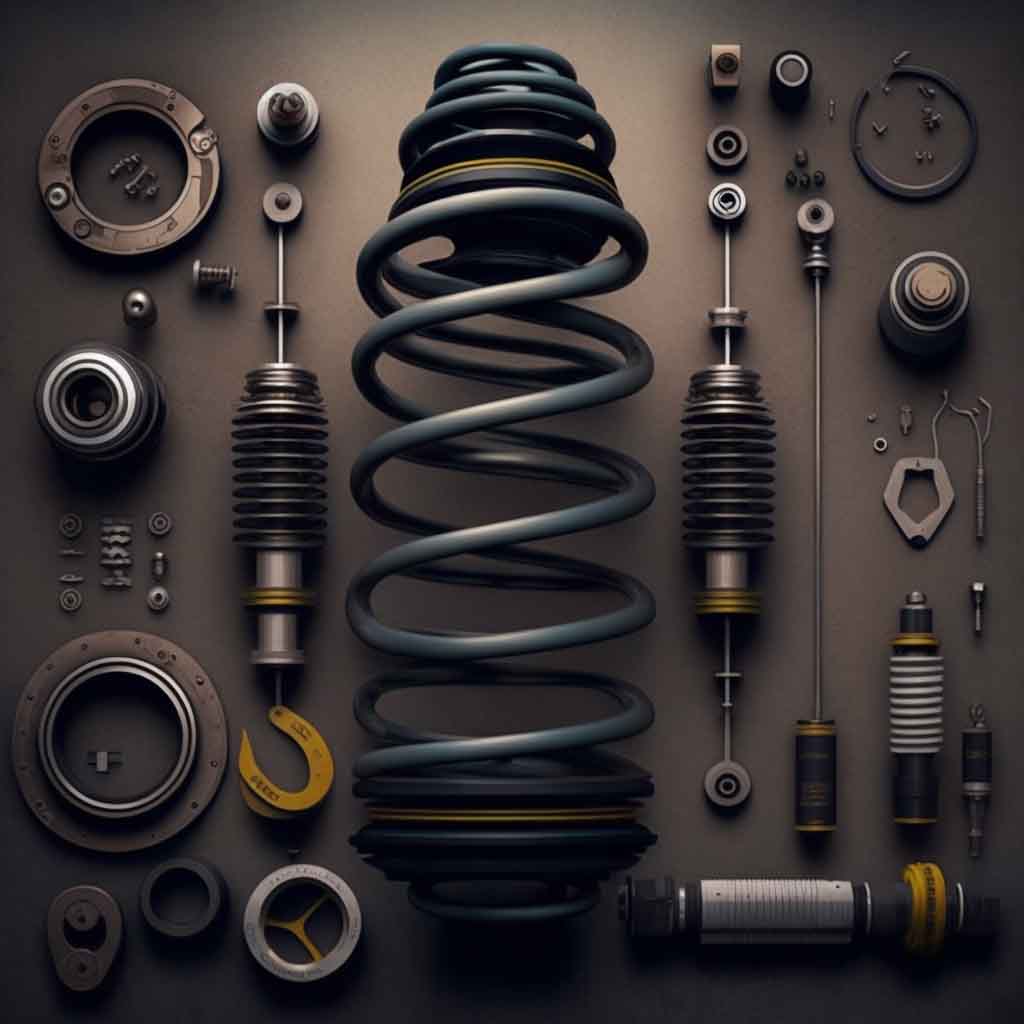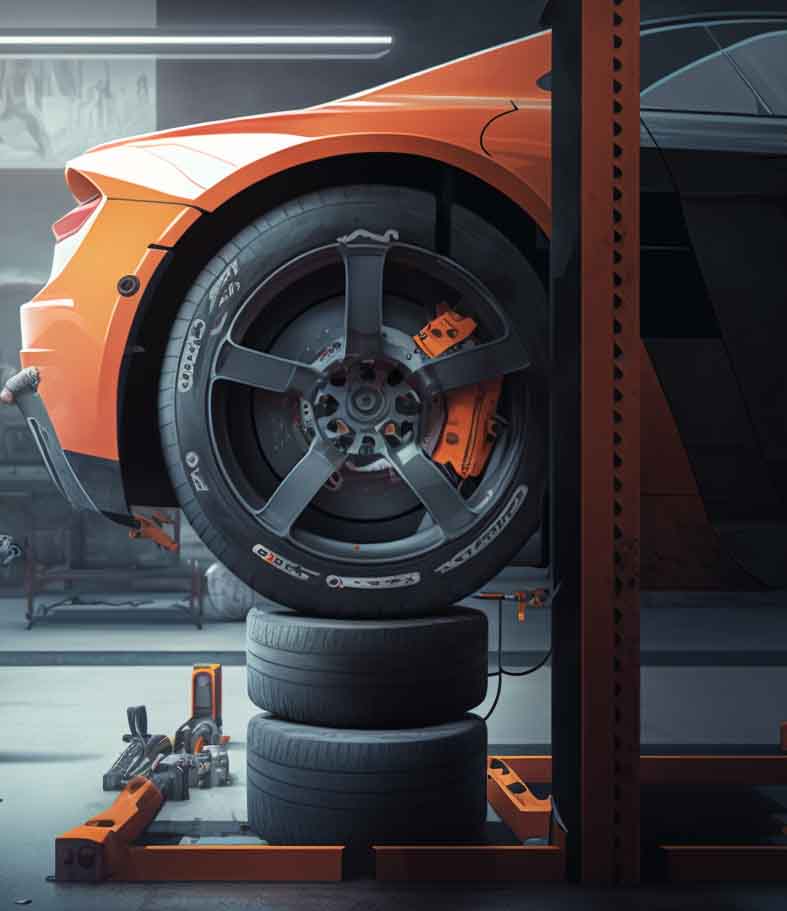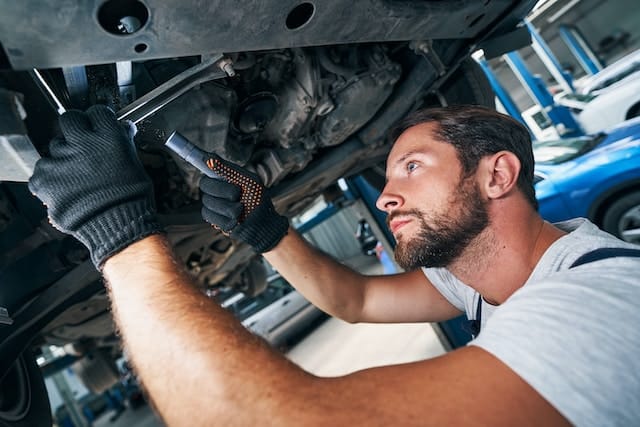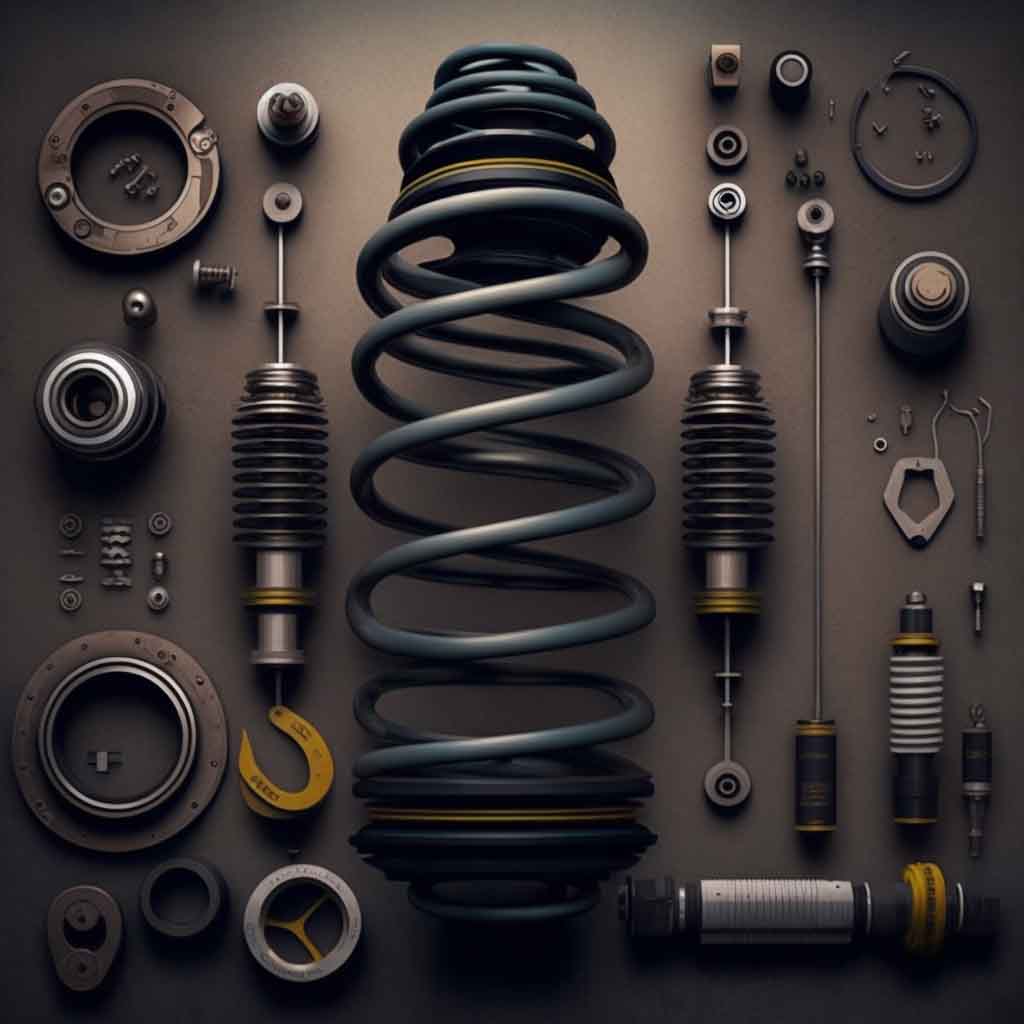
The suspension system in a vehicle is crucial for providing a comfortable ride and maintaining control while driving. It consists of various components that work together to absorb shocks, keep tires in contact with the road, and ensure stability. Over time, these components may wear out or become damaged, necessitating repairs or even a full replacement. This article will provide an introduction on suspension repair or replacement costs, common issues, and tips to minimize expenses.
Suspension Longevity: Can You Avoid Suspension Repairs Throughout Your Vehicle’s Lifetime?

While it’s possible for a vehicle’s suspension system to remain relatively trouble-free throughout its lifetime, it’s not very common. Suspension components are subject to wear and tear due to various factors such as road conditions, driving habits, and the vehicle’s age. As a vehicle accumulates mileage, the likelihood of encountering suspension-related issues increases.
For instance, shock absorbers and struts typically have a service life of 50,000 to 100,000 miles, depending on the quality of the parts and driving conditions. Similarly, other suspension components like bushings, ball joints, and control arms may eventually wear out and require replacement.
To minimize the chances of encountering suspension problems, it’s crucial to practice regular maintenance, adhere to the recommended inspection intervals, and address any potential issues promptly. This approach can prolong the life of your suspension system and help you avoid unexpected repair costs.
Completely avoiding suspension repair or replacement costs throughout the lifetime of a vehicle, especially one that reaches 100,000 or 200,000 miles, is unlikely. Regular wear and tear, as well as the potential for encountering poor road conditions or accidents, make it almost inevitable that some suspension maintenance will be necessary over time.
Factors Affecting Suspension Repair or Replacement Costs

Several factors contribute to the cost of repairing or replacing a suspension system, including:
Make and model of the vehicle
Luxury or high-performance vehicles may have more expensive components or specialized systems, increasing repair or replacement costs.
Type of suspension system
There are four primary types of suspension systems – leaf spring, coil spring, torsion bar, and air suspension. Each system has different components and varying costs.
Severity of the problem
Minor issues may only require adjustments or replacement of a single component, while severe problems could involve replacing multiple parts or the entire suspension system.
Labor costs
The hourly rate for labor can vary significantly depending on the mechanic, their expertise, and the geographic location.
Geographic location
Prices for parts and labor may vary based on regional differences in the cost of living and availability of resources.
Common Suspension Problems and Associated Costs
Some common suspension problems and their associated costs include:
Worn or damaged shock absorbers
Replacing shock absorbers typically costs between $250 and $600 per pair, including parts and labor.
Broken or damaged coil springs
Replacing coil springs ranges from $300 to $800, depending on the make and model of the vehicle.
Faulty or damaged struts
Strut replacement usually costs between $400 and $900 per pair, including parts and labor.
Worn or damaged control arms and bushings
Replacing control arms and bushings can range from $200 to $500 per component, depending on the vehicle’s make and model.
Sway bar problems
Repairing or replacing sway bars and related components typically costs between $100 and $400, depending on the severity of the issue.
Cost Comparison: Repair vs. Replacement
Repair costs
Minor repairs
Minor suspension issues, such as replacing bushings or adjusting alignment, can range from $50 to $200.
Major repairs
More extensive repairs, like replacing multiple components, can cost between $500 and $2,000 or more.
Replacement costs
Partial replacement
Replacing a single component or a few parts may range from $200 to $1,500, depending on the parts involved.
Full replacement
A complete suspension system replacement can cost anywhere from $1,500 to $5,000 or more, depending on the vehicle and suspension type.
Factors to Consider When Deciding Between Repair and Replacement
Age and condition of the vehicle
Older vehicles may be more prone to suspension problems, and the cost of repairs may exceed the vehicle’s value.
Cost-effectiveness
Evaluate whether it’s more cost-effective to repair individual components or replace the entire system.
Safety concerns
If the suspension issues compromise the vehicle’s safety, a full replacement may be the best option.
Tips to Reduce Suspension Repair or Replacement Costs
Regular maintenance and inspections

Routine check-ups can help identify and address issues before they become severe or expensive to fix.
Addressing issues early
Don’t ignore signs of suspension problems, as they may worsen and lead to more costly repairs or even damage other components.
Seeking multiple quotes
Obtain quotes from various mechanics or repair shops to ensure you are getting a competitive price.
DIY repair options
For those with mechanical skills, tackling minor suspension repairs on your own can save on labor costs. However, be cautious and consult a professional if unsure.
Proactive Suspension Maintenance: When to Check Your Vehicle’s Suspension System
Even if you don’t notice any obvious problems with your vehicle, it’s still essential to periodically check your suspension system to ensure optimal performance and prevent potential issues. Regular inspections can help identify early signs of wear and tear, allowing you to address problems before they become more severe and costly.
As a general rule, it’s a good idea to have your suspension system inspected during routine maintenance, such as oil changes or tire rotations. Typically, these services occur every 3,000 to 7,000 miles, depending on your vehicle and driving conditions. Additionally, it’s recommended to have a thorough suspension inspection at least once a year.
However, some factors may require more frequent checks, such as driving on rough or uneven terrain, carrying heavy loads, or encountering harsh weather conditions. In these cases, consult your owner’s manual or a trusted mechanic for guidance on the appropriate inspection intervals for your specific vehicle and driving habits.
Warranty and Insurance Considerations
Understanding warranty coverage
Review your vehicle’s warranty to determine if it covers suspension repairs or replacements. Some warranties may cover specific components or offer limited coverage.
Insurance claims and coverage
If your suspension damage is the result of an accident or incident covered by your auto insurance policy, you may be eligible for coverage. Consult your insurance provider for details.
Extended warranties and third-party options
If your vehicle’s original warranty has expired, consider purchasing an extended warranty or third-party coverage to help offset the cost of future suspension repairs.
Frequently Asked Questions about Suspension Repair and Replacement Costs

Keeping your suspension system in good condition is essential for a comfortable, safe, and smooth driving experience. Weigh the pros and cons of repairing or replacing components based on your vehicle’s age, condition, and the severity of the problem. By maintaining a proactive approach to vehicle maintenance and addressing suspension issues early, you can minimize repair or replacement costs and ensure a safe and comfortable ride.
What are the common signs of suspension problems?
Common signs include a bumpy or uncomfortable ride, uneven tire wear, excessive bouncing, pulling to one side, nose-diving when braking, and difficulty steering or maintaining control of the vehicle.
How often should I have my suspension system inspected?
It is recommended to have your suspension system inspected during routine maintenance, such as oil changes or tire rotations, or at least once a year. However, if you notice any of the common signs of suspension problems, schedule an inspection immediately.
Can I repair my suspension system myself?
If you have mechanical skills and experience, you may be able to tackle minor suspension repairs. However, some repairs require specialized tools or knowledge and should be handled by a professional mechanic.
Is it always necessary to replace the entire suspension system?
No, it’s not always necessary to replace the entire suspension system. In many cases, only specific components may need to be repaired or replaced. However, if multiple parts are damaged or worn out, a full replacement may be more cost-effective.
How long does it take to repair or replace a suspension system?
The time required for a suspension repair or replacement depends on the complexity of the issue and the availability of parts. Minor repairs may take a few hours, while a full replacement could take one to three days.
Are suspension repairs or replacements covered by insurance?
Suspension repairs or replacements may be covered by insurance if the damage is the result of a covered accident or incident. It’s essential to consult your insurance provider to determine the extent of coverage for your specific policy.
Can I drive my vehicle with a damaged suspension system?
While it may be possible to drive a vehicle with a damaged suspension system, it can be dangerous and may cause further damage to your vehicle. It’s best to have the issue addressed as soon as possible to ensure a safe and comfortable ride.
How can I prolong the life of my suspension system?
To prolong the life of your suspension system, practice regular maintenance and inspections, address issues early, maintain proper tire inflation, and avoid overloading your vehicle.
What is the difference between shocks and struts?
Shocks and struts are both components of a vehicle’s suspension system designed to absorb impacts and maintain ride comfort. Shocks (short for shock absorbers) are standalone components, while struts are integrated assemblies that include a shock absorber, a coil spring, and a structural element.
How can I tell if my shock absorbers or struts need to be replaced?
Signs that your shock absorbers or struts may need replacement include a bumpy ride, excessive bouncing, nose-diving during braking, uneven tire wear, and fluid leaks around the shock absorber or strut.
Can worn suspension components affect tire wear?
Yes, worn suspension components can cause uneven tire wear due to improper alignment, reduced tire contact with the road, and increased stress on the tires.
Is it necessary to perform a wheel alignment after a suspension repair or replacement?
Yes, it is generally recommended to perform a wheel alignment after a suspension repair or replacement to ensure proper tire contact with the road and prevent uneven tire wear.
Are aftermarket suspension components as reliable as original equipment manufacturer (OEM) parts?
The quality and reliability of aftermarket suspension components can vary widely. Some aftermarket parts may be of equal or higher quality than OEM parts, while others may be of lower quality. It’s important to research and choose reputable aftermarket brands for the best results.
How can I find a trustworthy mechanic or repair shop for suspension repairs or replacements?
To find a trustworthy mechanic or repair shop, ask for recommendations from friends, family, or online review platforms. Look for mechanics with experience working on your vehicle’s make and model, and consider obtaining multiple quotes to compare prices and services.
Is it necessary to replace shock absorbers or struts in pairs?
Yes, it is generally recommended to replace shock absorbers or struts in pairs (either both front or both rear) to ensure even and balanced performance. Replacing only one can lead to uneven handling and ride quality.
Can a suspension upgrade improve my vehicle’s performance?
Yes, upgrading your suspension can improve your vehicle’s handling, stability, and ride comfort. Common upgrades include performance shock absorbers, stiffer springs, and adjustable sway bars. However, it’s essential to research and choose components compatible with your vehicle and driving needs.
How do I know if my vehicle has an air suspension system?
Air suspension systems use airbags instead of conventional springs to support the vehicle’s weight. To determine if your vehicle has an air suspension system, consult your owner’s manual or look for air suspension components, such as airbags or air compressors, under your vehicle.
What can cause a suspension system to fail prematurely?
Several factors can contribute to premature suspension system failure, including poor-quality components, excessive wear and tear due to harsh driving conditions, overloading, and neglecting regular maintenance.
Can I use suspension components designed for off-road use on my daily driver?
Off-road suspension components, such as lift kits and heavy-duty shocks, are designed for specific off-road driving conditions and may not be suitable for everyday driving. Using off-road suspension components on a daily driver could result in a rough ride, reduced handling performance, and increased wear on other components.
Are there any warning lights on the dashboard related to suspension issues?
Some vehicles, particularly those with electronic or air suspension systems, may have warning lights on the dashboard to alert drivers of potential suspension problems. Consult your owner’s manual to understand the warning lights specific to your vehicle.
Can potholes or road debris cause suspension damage?
Yes, hitting potholes or road debris can cause damage to your suspension system, including bent or broken components, misalignment, and even tire damage. It’s essential to drive cautiously and avoid such obstacles when possible.


